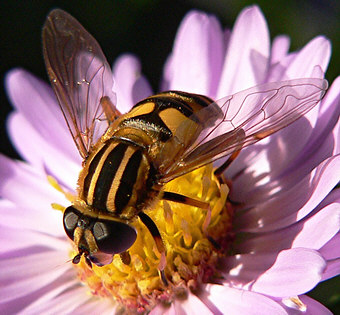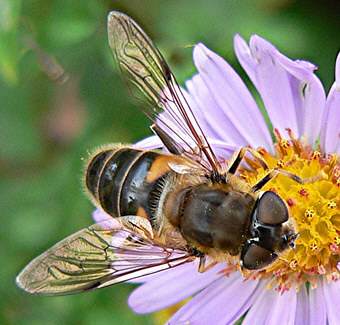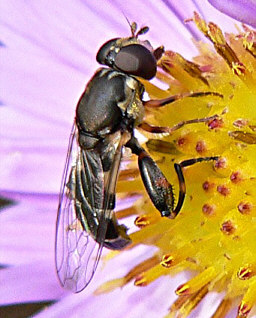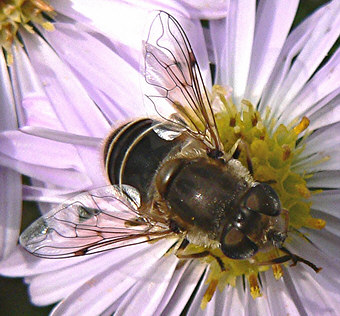 |
||||
Why look at Hoverflies?
 Helophilus pendulus
Helophilus pendulus
 Eristalis pertinax
Eristalis pertinax
How to recognise a hoverfly
Hoverflies come in a surprising variety of sizes, shapes and colours. As insects, they of course have six legs, and their bodies are formed of three main parts - head, thorax (from shoulders to waist) and abdomen (from waist to tail tip). The smallest of the 300 or so British species are barely bigger than a garden ant, and the largest near the size of a hornet. Some are slender, with elongated wasp-waists, and others are as stout as bumble bees. Many are plain black, and a few are pale whitish, grey or buff; but perhaps the majority show what many people would regard as the classic hoverfly colours - black with bright spots or bands of white, yellow, orange or red.
Particularly in this last group, hoverflies resemble stinging wasps or bees, which must give them some protection from predators. Unlike bees and wasps, however, hoverflies have two not four wings. Where this feature is not obvious (as when the wings are folded), a close look at a hoverfly will reveal large compound eyes, which take up most of the head and are often brownish or reddish in colour: bees and wasps have smaller, black eyes, of a curved, somewhat comma-like shape. Bees and wasps always have long and flexible antennae; those of most hoverflies are short, and in the uncommon cases where they are long, they show other obvious differences. However, the superficial resemblance to honeybees (for example by Eristalis hoverflies), to bumblebees (by Pocota or Volucella ) and to wasps (by Chrysotoxum ) is often very wonderful.
 Syritta pipiens
Syritta pipiens
If the need arises, hoverflies can always be told by the unique pattern of veins in their wings, particularly the presence of a "false vein" which appears as a straight dark line near the middle of the wing, and is easy to see once you get used to looking for it.
A very good guide to what is a hoverfly is given by its behaviour. Most obviously, some species (though by no means all), regularly hover, holding position with remarkable steadiness and for much longer periods than other flies, or even than such accomplished flyers as dragonflies, bees and wasps. Note in particular that the familiar, tawny-coloured and furry bee-fly Bombylius major hovers beautifully, but it shows a long, permanently straight proboscis and is not in fact closely related to the hoverflies. Hoverflies are, above all, lovers of flowers and blossom. Often, on a hedge and verge in spring, or a garden border in summer, the majority of the flies present will be hoverflies. Watching and distinguishing them in such pleasant places is no particular hardship!
 Eristalis arbustorum
Eristalis arbustorum
Getting good views
Some hoverflies are very easy to identify. Even from twenty metres away, there is no mistaking the large black and white Volucella pellucens as it hangs high in the woodland sunlight. A dozen or more common species can be identified with a quick glance as we walk past a flowerbed. Less readily identifiable hoverflies will often allow surprisingly close views. Particularly when they are feeding or basking in the sun; they will remain still as we gradually bring our eyes up close enough to see details. With some experience, dozens more can be identified in this way. It is also quite easy to catch hoverflies directly into a suitable transparent receptacle such as a jar or even a large glass tube: a cautious approach and a quick final movement will often do the trick. This of course enables a more prolonged study, without harming the fly.
The next logical step is to bring a hand-lens to bear; a magnification of ten times will enable fine detail to be seen. In this way, it will be possible to identify many additional species with some confidence. A butterfly net will bring more hoverflies into the tube for examination. In some situations (for instance when hoverflies are feeding on tall ivy), a pair of binoculars can be useful, and close-focus binoculars will enable the identification of many species without the need to catch them. Modern digital cameras allow some surprisingly good hoverfly images to be taken quite straightforwardly, often showing crucial identification features that can be studied at leisure. It must be said that some hoverfly identification requires the use of specimens and a microscope, but a very great deal can be done without going to such lengths.
Get in touch
The Bedfordshire County Hoverfly Recorder is always pleased to receive records of hoverflies, descriptions, photographs and specimens requiring identification, or to help in other ways in connection with these insects. Here are his contact details.
Bedfordshire County Hoverfly Recorder
All images © John O'Sullivan